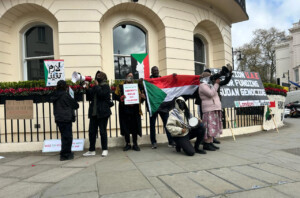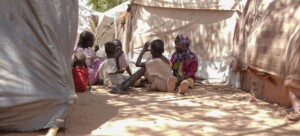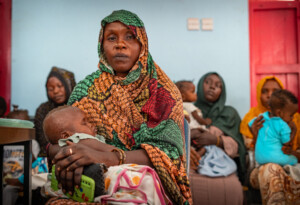Sudan OCHA bulletin 16: WHO, partners responding to watery diarrhoea/cholera
Last week the Sudanese Minister of Health visited South Darfur’s Kalma camp for the displaced to witness the response to ‘Acute Watery Diarrhoea (AWD). Heavy rains and subsequent flash floods have destroyed or damaged more than 2,000 homes in North and South Darfur. About 15,000 displaced people have reportedly returned to their home areas in Jebel Marra. According to the latest Food and Agriculture Organization (FAO) Global Information and Early Warning System on Food and Agriculture (GIEWS) report, sowing activities have benefited from an early onset of the rainy season.
Last week the Sudanese Minister of Health visited South Darfur’s Kalma camp for the displaced to witness the response to ‘Acute Watery Diarrhoea (AWD). Heavy rains and subsequent flash floods have destroyed or damaged more than 2,000 homes in North and South Darfur. About 15,000 displaced people have reportedly returned to their home areas in Jebel Marra. According to the latest Food and Agriculture Organization (FAO) Global Information and Early Warning System on Food and Agriculture (GIEWS) report, sowing activities have benefited from an early onset of the rainy season.
The UN Office for the Coordination of Humanitarian Affairs (OCHA) reports in its 16th bulletin of this year that the Sudanese Minister of Health, accompanied by representatives of the UN Children’s Agency (Unicef) and the World Health Organisation (WHO), visited South Darfur’s Kalma camp, where the South Darfur Ministry of Health, WHO, Unicef, and other humanitarian partners continue efforts to contain the AWD situation.
Kalma camp hosts about 126,000 displaced, some of whom were affected by recent flash floods. In response to AWD, and possible effects of these floods on the spread of the infectuous disease, humanitarian actors have established isolation treatment centres, run by International Medical Corps (IMC) and American Refugee Committee (ARC) with the support of WHO and Unicef.
The four INGOs active in the camp, IMC, ARC, CARE Switzerland, and Oxfam are also monitoring water quality and carrying out water chlorination, as well as solid waste management. Scaling up support for health, water and sanitation is required and affected households need plastic sheets for shelter.
The delegation also visited Nyala Teaching Hospital where WHO is supporting a Cholera Treatment Centre. Water quality control measures are also in place at the hospital, aided by the water quality testing kits provided by WHO. The South Darfur Health Ministry sent two nurses and two physicians to support the Centre. Furthermore, two month's supplies of medicine and equipment have been pre-positioned at the Ministry’s facilities.
Rains, flash floods affect homes in North and South Darfur
Heavy rains and subsequent flash floods have either destroyed or damaged 2,121 homes (affecting about 10,600 people) in North and South Darfur. In North Darfur.
The national NGOs Dar El Salam Development Association and Africa Humanitarian Action, in coordination with the local community, identified the needs of the about 1,400 people (281 homes) affected by the heavy rains in North Darfur’s Tawila and Dar El Salam localities.
The governmental Humanitarian Aid Commission (HAC) in South Darfur’s Mershing locality reported that on 5 July, heavy rains and flash floods destroyed at least 170 homes (affecting about 850 people) and damaging another 242 homes (affecting about 1,200 people). In addition, 62 gardens and farms in Mershing town were destroyed.
Also in South Darfur, the International Organization for Migration (IOM) verified 1,400 displaced families (about 7,200 people) who were affected by heavy rains and flash floods in the Kalma and Otash camps on 20 June.
In response to these needs—as well as for AWD response—Unicef has provided 200 latrine slabs, as well as chlorine for water treatment in both camps through the government’s Water and Environmental Sanitation Department (WES).
Returns to northern Jebel Marra
From 5 to 9 July, a joint inter-agency (IA) mission, led by OCHA and HAC in Central Darfur, visited Rokoro town and surrounding villages to assess humanitarian needs.

Northern Jebel Marra has been mainly inaccessible to aid organisations for a number of years and fighting in the area first in 2015 and later in January 2016 led to the displacement of people from the area. Since the beginning of 2017, there has been significant improvement in humanitarian access to Jebel Marra.
According to the local community, since early this year an estimated 15,000 people have returned to Fanga Suk, Burgo, Kaya, Logo, and Aro villages, and returns are continuing.
Women make up over 65 per cent of the population, and over 80 per cent of school-age children -the majority of whom are girls- are reportedly out of school, according to the mission's findings.
The main humanitarian needs in the area include food, emergency household supplies, water -as all the villages were found to consume water from unsafe sources- health and education assistance.
Facilities for basic services including schools, health centres and water points are either dilapidated owing to neglect and lack of repair or had been destroyed during past conflicts. Aid organisations are developing a comprehensive plan to respond to the needs of the affected people.
Malnutrition was observed among children and routine immunizations have not been carried out in the area for a long time. Some children as old as 13 years have never been immunized.
Planting of 2017 cereal crops benefiting from early onset of seasonal rains
According to the latest FAO GIEWS report, planting of 2017 Sudan’s main staple cereals sorghum and millet crops, to be harvested from October, has recently started in main southern cropping areas.
Land preparation and sowing activities benefited from an early onset of the June-September rainy season, with abundant rains received between 1 and 20 May.
The results of the latest Integrated Food Security Phase Classification analysis, valid for the period June-September 2017, indicates that about 3.4 million people throughout the country are estimated to be severely food insecure at present.
The FEWS NET Sudan Food Security Outlook (June 2017 to January 2018) highlights that humanitarian assistance needs are expected to remain high due to continued needs among displaced and resident households in South Kordofan and Blue Nile, displaced in Jebel Marra, refugees from South Sudan, households in localised areas that saw poor harvests in 2016, as well as well as long-term displaced people.











 and then
and then